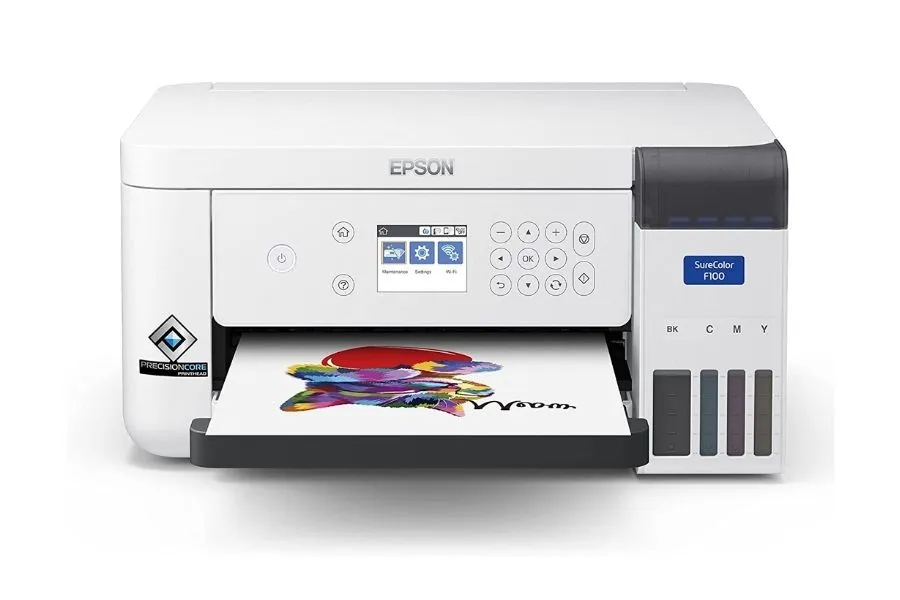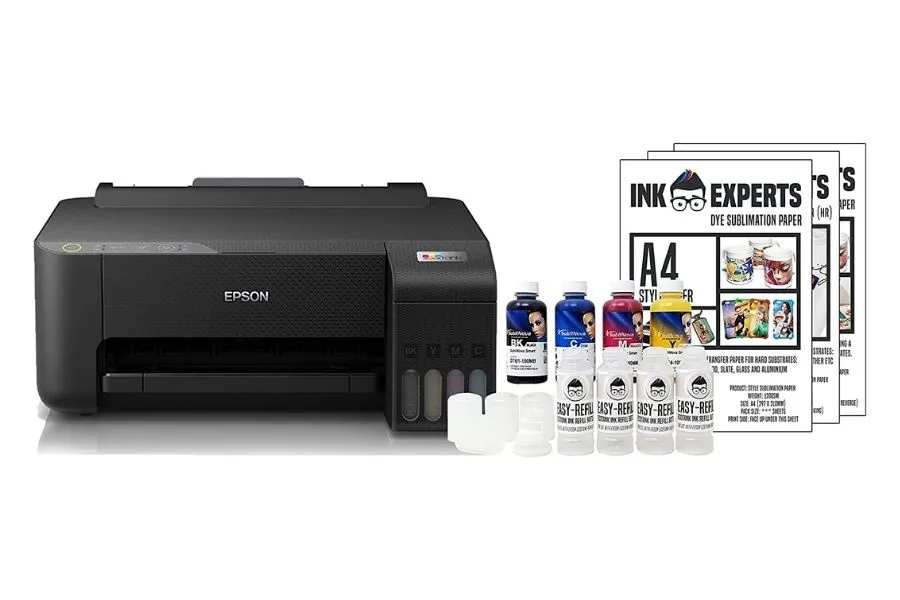Not all printers are the same: many have very specific uses and advantages. While commonly used laser or inkjet printers are great for printing documents or photos, Sublimation printers are perfect for photography, apparel and textile printing.
A sublimation printer is a heat-based printer that allows users to make high-quality photo prints or print onto a range of materials, from ceramics and fabric to metal or wood. It’s a great option for creating customised clothing, pillows, mugs, wall art and many more.
If you’re looking to get your hands on this versatile piece of printing technology, we’ve listed our picks below. The printers can vary in price, depending on their features and intended uses, varying from under £300, to way over the £1,000 mark.
We’ve tried to include an option for every budget and intended use. The product dimensions are all listed in terms of width x depth x height.
Best sublimation printers
Epson SureColour SC-F100

This mid-priced printer from Epson claims to be their first A4 dye sublimation printer. This limited size means it’s mostly aimed at producing smaller merchandise or gifts, such as mugs or phone covers.
The SureColour SC-F100 features a front-feeding system, with paper change functionality which is said to be easy to use and able to hold up to 150 sheets.
Epson say it offers a low cost of ownership for small businesses, requiring no specialist knowledge for set-up or maintenance.
Dimensions: 37.5 x 34.7 x 18.7 cm
Printing Size: A4
Connectivity: Wi-Fi, Wi-Fi Direct, Ethernet, USB 2.0
Ink Experts ET-2814 Printer Bundle

This starter bundle from Ink Experts aims to provide everything needed to get a beginner started. It includes an Epson Ecotank ET-2814, a budget printer that aims to provide good value for money.
The main selling point of this printer is access to Epson’s EcoTank with high yield ink bottles and no cartridges to replace, which the brand claim allows for a 90% saving on printing costs.
Ink Experts include their Ink Tec Sublinova Smart inks, which they say are manufactured to be used in Epson printers. The ink can reportedly be used as a direct to garment ink, making use of Epson Micro Piezo print head technology.
This means it should transfer onto most synthetic materials, from polyester and nylon to ceramics.
Dimensions: 37.5 x 34.7 x 17.9 cm
Printing Size: A4
Connectivity: USB, WiFi, Wi-Fi Direct
Epson SureColor F570
- Buy now from Epson (£2,334.79)

This premium printer is said to be designed for high-performance printing. It features Epson’s PrecisionCore MicroTFP printhead, which aims to provide high clarity and reliability.
It’s able to accommodate printing on sheets or items up to 60cm. There’s an auto-feed tray with up to 50 sheets, plus a built-in cutter to cut your prints to the right size.
There are a range of other features that aim to ensure this printer is suitable for professionals, such as their Epson Edge Print Pro software, which is designed to streamline your workflow. It connects with Adobe programmes to help with pattern repeats and colour controls.
Dimensions: 97.0 x 81.1 x 24.5 cm
Printing Size: Up to 60cm wide
Connectivity: SuperSpeed USB (USB 3.0), Wired Ethernet, Wi-Fi Direct
Epson SureColor SC-T5100N (£1,631.70)
- Buy now from Epson (£1,631.70)

If you’re looking for a premium large-format printer, Epson claim their SureColor SC-T5100N is designed for large, detailed prints for architects, engineers, or advertisements.
The printer features Epson’s Nozzle Verification Technology, which is designed to help avoid misprints, with their PrecisionCore Print Head for detail―with a printing resolution of 2,400 x 1,200 DPI.
This printer also features UltraChrome XD2 pigment ink, which Epson say ensures prints are smudge proof and water resistant.
Dimensions: 97.0 x 81.1 x 24.5 cm
Printing Size: Up to 91cm
Connectivity: SuperSpeed USB (USB 3.0), Wired Ethernet, Wi-Fi Direct
How does a sublimation printer work?
The sublimation printing process involves the use of heat to transfer dye. It involves printing onto a sheet of paper, which is then brought under heat and pressed onto the material desired.
The process uses special sublimation ink, a solid dye which is transformed into a gas without passing through a liquid state, hence the term "sublimation." The gas then permeates the surface of the printing medium and solidifies into a print.
This separates a sublimation printer from a printer that can use dye sublimation to print. While “sublimation printing” is a specific digital printing process, “dye sublimation” refers to the type of dye used in the process.
These terms are often used interchangeably, so it’s good to draw a distinction. Not all printers that use dye sublimation are sublimation printers.
What is the printing process using a sublimation printer?
- Design: Create or select the desired image or design on a computer.
- Printing: The sublimation printer applies heat to the solid dye pigments, converting them into a gas that is then transferred onto a special transfer paper.
- Transfer: The printed transfer paper is placed on the material to be printed, such as a T-shirt or mug.
- Heat press: The material, along with the transfer paper, is subject to high temperature and pressure using a heat press machine. The heat causes the dye gas to penetrate the material's surface, resulting in a permanent transfer of the image.
What software do I need to use a sublimation printer?
To use a sublimation printer, you typically need graphic design software like Adobe Photoshop to create and edit designs.
Template software can help position designs on specific product templates. Always check your printer manufacturer's recommendations for compatible software options.
What are the advantages of a sublimation printer?
- High-quality prints: Sublimation printing produces vibrant and detailed prints with continuous tones, smooth gradients, and sharp images.
- Long-lasting prints: The sublimation process creates prints that are resistant to fading, peeling, and cracking, ensuring durability over time.
- Versatility: Sublimation printers can be used on a wide range of materials, including textiles, ceramics, metals, and more.
- Full-colour printing: Sublimation printers can produce full-colour prints with precise colour reproduction, allowing for the printing of complex designs and photographs.
What should you look for in a sublimation printer?
- Printing Technology: Ensure that the printer is specifically designed for sublimation printing. While you can convert other printers into sublimation printers, you should have the necessary components and mechanisms to handle sublimation inks and produce high-quality sublimation prints.
- Ink Compatibility: Check if the printer is compatible with sublimation inks. Some printers may require specialised cartridges or systems to accommodate sublimation inks. It's important to ensure that the printer supports the specific ink formulation you plan to use.
- Print Size and Format: Consider the maximum print size and supported paper formats of the printer. Choose a printer that can accommodate the print sizes you require for your intended applications. Common sizes include 8.5" x 11", 11" x 17", and larger format options.
- Connectivity Options: Check the available connectivity options of the printer. USB, Ethernet, and Wi-Fi connectivity are common features that allow you to connect the printer to your computer or network for easy printing.
Top image credit: Evelyn Geissler/Unsplash